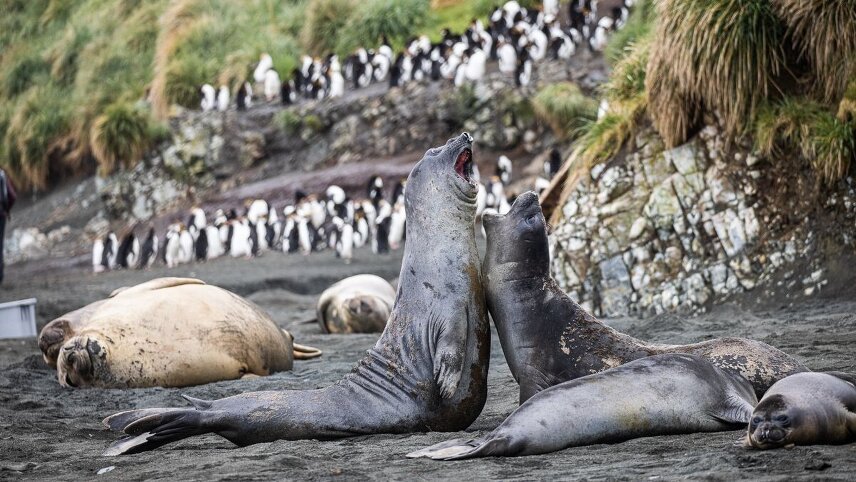Overview
The islands occupy the tempestuous latitudes of the Roaring Forties and the Furious Fifties, but they are also known as the Albatross Latitudes and with good reason. Ten of the world's albatross species breed in the region; five of them nowhere else but here! In fact, this zone where the air is never still hosts the most diverse collection of seabirds in the world. More than 40 species breed here - that is at least 11 per cent of the entire world's seabird population.
With the exception of the Chathams, the islands are all designated UNESCO World Heritage sites and are afforded the highest conservation status and protection by the Australian and New Zealand governments, so passage to their shores is not granted lightly. There are also islands that we visit within the Chatham Islands' Archipelago with similar status and protection.
This expedition has huge appeal to pelagic enthusiasts, penguin fanatics and those interested in island endemics. Though you don't have to be a keen birder to enjoy this voyage. People interested in islands and island ecology, botany, geology and an increasing number of photographers have enjoyed this trip immensely, as have those interested in the history of southern ocean discovery and exploration.
This is one of our ‘signature expeditions' which has operated annually for more than 20 years, so you will benefit from the knowledge and expertise gained over that time.
Itinerary
Guests should make their way to the designated hotel where we will spend the first night of the expedition.
This evening there will be an informal get-together at the hotel for dinner; an excellent opportunity to meet fellow adventurers on your voyage and some of our expedition team.
Today we enjoy breakfast in the hotel restaurant and have the morning free to explore Queenstown before returning to the hotel for lunch and departing for the Port of Bluff to embark your ship. You will have time to settle into your cabin and familarise yourself with the ship; we will also take the opportunity to conduct a number of safety briefings. You are invited to join the expedition team in the Observation Lounge and up on the Observation Deck as we set our course to The Snares and our adventure begins.
The closest Subantarctic Islands to New Zealand, they were appropriately called The Snares as they were once considered a hazard for sailing ships. Comprising of two main islands and a group of five islands called the Western Chain; they are uninhabited and enjoy the highest protection as Nature Reserves. It is claimed by some that these islands are home to more nesting seabirds than all of the British Isles together.
We plan to arrive in the morning, and as landings are not permitted, we will Zodiac cruise along the sheltered eastern side of the main island if the weather and sea conditions are suitable. In the sheltered bays, we should see the endemic Snares Crested Penguin, Snares Island Tomtit and Fernbirds. There are hundreds of thousands of Sooty Shearwaters nesting on The Snares; the actual number is much debated. Buller's Albatross breed here from early January onwards. There will be opportunities to view the forests of large tree daisy Olearia lyallii which forms a canopy over much of the island group.
The Auckland Islands group was formed by two volcanoes which erupted some 10-25 million years ago. They have subsequently been eroded and dissected by glaciation creating the archipelago as we know it today. Enderby Island is one of the most beautiful islands in this group and is named after the same distinguished shipping family as one of our own vessels.
This northern most island in the archipelago is an outstanding wildlife and birding location and is relatively easy to land on and walk around. The island was cleared of all introduced animals (pests) in 1994 and both birds and the vegetation, especially the herbaceous plants, are recovering both in numbers and diversity.
Our plan is to land at Sandy Bay, one of three breeding areas in the Auckland Islands for the Hooker's or New Zealand Sea Lion, a rare member of the seal family. Beachmaster bulls gather on the beach, defending their harems from younger (ambitious) males, to mate with the cows shortly after they have given birth to a single pup. Hooker's or New Zealand Sea Lion numbers are in a slow decline, for reasons which are not obvious but most probably connected with a nearby squid fishery.
During our day ashore there will be several options, some longer walks, some shorter walks and time to spend enjoying the wildlife. The walking is relatively easy. A boardwalk traverses the island to the dramatic western cliffs, from there we follow the coast and circumnavigate the island. Birds that we are likely to encounter include the following species: Southern Royal Albatross, Northern Giant Petrel, Auckland Island Shag, Auckland Island Flightless Teal, Auckland Island Banded Dotterel, Auckland Island Tomtit, Bellbird, Pipit, Red-crowned Parakeet, Yellow-eyed Penguin and Light-mantled Sooty Albatross.
There is also a very good chance of seeing the Subantarctic Snipe. Other more common species we will see include the Goldfinch, Song Thrush, Blackbird, European Starling, Red-billed Gull and Redpoll. On Derry Castle Reef we will look for migratory waders which could include Bar-tailed Godwit, Turnstone and possibly vagrants.
As we make our way through an area known as the Furious Fifties in the tumultuous Southern Ocean, we will learn more about the flora and fauna as we prepare for our arrival at Macquarie Island. En route there are great birding opportunities which may include the Wandering Albatross, Royal Albatross, Black-browed Albatross, Light-mantled Sooty Albatross, Salvin's Albatross, Grey-headed Albatross, Northern and Southern Giant Petrel, Sooty Shearwater and Little Shearwater.
We will endeavour to spot the Fairy Prion, Fulmar Prion and Antarctic Prion – never an easy task – but we should get some great views. Other species to be on the lookout for include the Soft-plumaged Petrel, Mottled Petrel, White-headed Petrel, Grey-faced Petrel, White-chinned Petrel, Grey-backed Storm-Petrel, Wilson's Storm-Petrel and the Black-bellied Storm-Petrel.
The great Australian Antarctic Explorer Sir Douglas Mawson once called Macquarie Island “One of the wonder spots of the world.” You are about to discover why as we spend two days exploring this amazing Island. It was one of the first of the Subantarctic Islands to obtain World Heritage Status and that was largely due to its unique geology. It is one of the few places on earth where mid-ocean crustal rocks are exposed at the surface due to the collision of the Australian and Pacific Plates.
The island was discovered in 1810 and was soon ravaged by sealers who introduced various animals including rats, mice, cats and rabbits. The native bird population was virtually eliminated and plants destroyed. The Tasmanian National Parks and Wildlife Service which administered the island recently embarked on a very ambitious eradication program which appears to have been successful. The island is now predator free and both the birds and plants are responding. It is amazing to witness the regeneration and the increase in the number of birds. Macquarie Island is home to four species of penguin, Kings, Royals, Gentoo and Rockhopper. The Royal Penguin occurs nowhere else in the world.
During our visit we will land at two sites (subject of course to weather and sea conditions) and you will get a chance to see, observe and photograph all four species, although the Rockhopper is much harder to capture than the others. Macquarie also has a large population of Southern Elephant Seals. Pups are born in October and weaned in November when the breeding adults return to sea. The weaners and sub adults lie around on the beaches. The weaners go to sea sometime in January, running the gauntlet of Orcas or Killer Whales who are waiting offshore.
We plan a landing at the Australian Antarctic Research Base at Buckles Bay where you will be able to meet with scientists and base staff. The original base was established in 1947 and the island has been ‘manned' since then. It is one of the longest continuously occupied bases in the Subantarctic.
At sea en route to Campbell Island and time to unwind after the adventures of Macquarie Island. Look for cetaceans and albatross, join a lecture or catch up on your photos and journaling.
Today we explore Campbell Island, New Zealand's southernmost Subantarctic territory. Its history is as rich and varied as the other islands we visit. Discovered in 1810, it was soon occupied by sealers who introduced rats and cats. Farming followed from 1895 to 1934 when it was abandoned. Coastwatchers were stationed on the island during the war and at the end of the war the station was taken over by the New Zealand Metrological service. They maintained a manned weather/ research station there until 1995.
In the early 1970s the removal of farm animals commenced and all were eventually removed by 1990. The vegetation recovered quickly and the cats died out naturally. In a very ambitious (and never before attempted on such a large scale) eradication programme the New Zealand Department of Conservation successfully removed the rats. With the island declared predator free, the way was clear to reintroduce the endangered Campbell Island Flightless Teal, which had been rediscovered on an offshore island in 1975. Snipe, which were formerly unknown from the island but were discovered on another offshore island, recolonised the islands themselves.
The vegetation which the great English botanist Sir Joseph Hooker described in 1841 as having a “Flora display second to none outside the tropics” is flourishing and is nothing short of spectacular. We will offer a number of options which will enable you to explore the island including an extended walk to Northwest Bay. There will also be an easier walk to the Col Lyall Saddle. All of these options will allow you the opportunity and time to enjoy the Southern Royal Albatross which nest here in large numbers. We also visit areas of the island which contain outstanding examples of the megaherbs for which the island is renowned.
At sea en route to the Antipodes, it is a day for pelagic birding. Species commonly seen in this area include Wandering Albatross species, Southern Royal Albatross, Black-browed Albatross, Campbell Island Albatross, Lightmantled Sooty Albatross, Salvin's Albatross, Grey-headed Albatross, Northern and Southern Giant Petrel, the Sooty Shearwater and the Little Shearwater. This region of the Southern Ocean is one of the few places where the Fairy Prion, Fulmar Prion and Antarctic Prion occur together, providing a good opportunity for comparison.
Other species to be on the lookout for include the Soft-plumaged Petrel, Mottled Petrel, White-headed Petrel, Grey-faced Petrel, Whitechinned Petrel, Grey-backed Storm-Petrel, Wilson's Storm-Petrel, Black-bellied Storm-Petrel and the Common Diving-Petrel.
The Antipodes group of islands is the most isolated and perhaps the least known of New Zealand's Subantarctic Islands. Sealers lived here in the decades immediately after their discovery in 1806. Mice are the only introduced animal on the islands but efforts to eradicate them will hopefully see that their days are numbered. The islands are of volcanic origin, but are heavily eroded especially the western shoreline. The largest of the group is Antipodes Island. Landings are not permitted so we plan to cruise, along the coastline by Zodiac where we have a good chance of seeing the Antipodes Parakeet, the largest of New Zealand's parakeets. This species has an entirely green head.
We will also look for the Reischek's Parakeet, a subspecies of the Red-crowned Parakeet found in the Auckland Islands and on the Chatham Islands. We also see the Antipodes subspecies of the New Zealand Pipit. Good views of both Erect-crested and Rockhopper Penguins can be expected along the coast where they often breed in mixed colonies.
We arrive at the incongruously named Bounty Islands, the remote northernmost of the five New Zealand Subantarctic groups; they were discovered by Captain Bligh just months before the infamous mutiny. Here inhospitable granite knobs, tips of the submerged Bounty Platform, are lashed by the Southern Ocean. They are home to thousands of Salvin's Albatross, Erect-crested Penguins, Fulmar Prions and the endemic Bounty Island Shag – the world's rarest.
We plan to arrive in the early morning and if conditions are suitable we will cruise by Zodiac around the granite outposts to take a closer look at the birds which breed there. New Zealand Fur Seals which were almost hunted to extinction in the Subantarctic Islands are present in large numbers. Sailing towards the Chatham Islands there are opportunities to see a good selection of birdlife as we sail. These should include Wandering Albatross, Northern Royal Albatross, Mottled Petrel, Soft-plumaged Petrel, Broad-billed Prion, White-chinned Petrel and Black-bellied Storm-Petrel as well as Wilson's Storm-Petrel.
Other possible sightings include White-capped Albatross, Northern Giant Petrel, Cape Petrel, Antarctic Fulmar, Sooty Shearwater, Little Shearwater and Grey-backed Storm-petrel. We will also start to keep a lookout for the Chatham Island Petrel.
As we continue toward the Chatham Archipelago, there are excellent opportunities for pelagic birding today. In particular, we will look out for the Chatham Island Petrel which has been seen on this leg of the voyage before. In the past we have observed the very rare Chatham Island Taiko in this area. Endemic to the Chatham Islands, the Chatham Island Taiko – also known as the Magenta Petrel – is among New Zealand's most endangered species. It is one of the world's rarest seabirds with a population estimated to number less than 150.
This afternoon we will cruise around spectacular Pyramid Rock, a basalt outcrop south of Pitt Island. This is the only breeding place of the Chatham Island Albatross. During the afternoon we arrive at South East Island. This has to be one of the world's greatest nature reserves and landings are not permitted. However we should obtain good views of the very rare New Zealand Shore Plover and Chatham Island Oystercatcher from the Zodiacs as we cruise along the coast. We should also see the Pitt Island Shag which nests on the island.
The Chatham Archipelago consists of one large island and numerous smaller islands and rocky islets. Only two of the islands are inhabited. They represent New Zealand's eastern most territory. The islands were originally settled by East Polynesians. In the 1400s the population became isolated and interestingly developed its own distinct culture. The islands were discovered by Europeans in the 1790s. Sealers and settlers followed and then in the 1830s Māori from New Zealand invaded killing and enslaving many of the indigenous people.
The impact of the original settlers, the Europeans and later the Maori people on the native flora and fauna was disastrous. Introduced animals, hunting, fires and land clearing wiped out many species of endemic birds. Fortunately a number survived on the offshore islands in the archipelago. With a new generation has come a new awareness and a willingness to be part of a concerted conservation effort. A number of private reserves have been established, a lot of replanting has taken place and predators are being controlled.
Today we will visit one of the original private reserves established by a local family on the south coast of the main island where there is a very good chance to see the endemic Chatham Island Pigeon and Warbler. The pigeon was close to extinction until recently, and is now in good numbers. We will travel by local bus to the reserve. The road takes us through developed farmland where we will undoubtedly see numerous introduced species and possibly the Weka. Near our landing in Waitangi there is a good chance of seeing the endemic Chatham Island Shag.
This afternoon we cruise back along the south coast, this is where the only known population of the Taiko breeds and also where they are attempting to establish a new population of the Chatham Island Petrel in a predator free area. We have seen both Taiko and Chatham Island Petrel in this area on previous expeditions.
En route to Bluff we will cross the Chatham Rise, a large, relatively shallowly submerged part of the Zealandia continent that stretches east from near the South Island of New Zealand. Nutrient rich waters from the south mix with warm northern waters and there is an overlap between northern pelagic species and birds from southern latitudes, so we can expect great pelagic sightings.
Species we expect to encounter include Wandering Albatross, Royal Albatross, Black-browed Albatross, White-capped Albatross and Salvin's Albatross. Petrel species we should be able to identify are the Northern Giant Petrel, Cape Petrel, Westland Black Petrel, White-chinned Petrel, Great-winged Petrel, Grey-backed Storm-Petrel, Whitefaced Storm-Petrel, the DivingPetrel and Cook's Petrel.
Additional birdlife will include species of shearwater seabirds. These tubenose birds fly with stiff wings and use a ‘shearing' flight technique to move across wave fronts with the minimum of active flight. Photographic opportunities can include Flesh-footed Shearwater, Buller's Shearwater, Sooty Shearwater and Little Shearwater. Small petrels on the horizon and close by include Fairy Prion and Broad-billed Prion. We will recap the highlights of our expedition and enjoy a farewell dinner tonight as we complete the last few miles of our journey.
Early this morning we will arrive in the Port of Bluff. After a final breakfast we bid farewell to our fellow voyagers and take a complimentary coach transfer to either Invercargill or Queenstown Airports. In case of unexpected delays due to weather and/or port operations we ask you not to book any onward travel until after midday from Invercargill and after 3pm from Queenstown.
Note: During our voyage, circumstances may make it necessary or desirable to deviate from the proposed itinerary. This can include poor weather and opportunities for making unplanned excursions. Your Expedition Leader will keep you fully informed. Landings at the Subantarctic Islands of New Zealand are by permit only as administered by the Government of New Zealand. No landings are permitted at The Snares, Antipodes or Bounties.
Life Onboard Heritage Adventurer
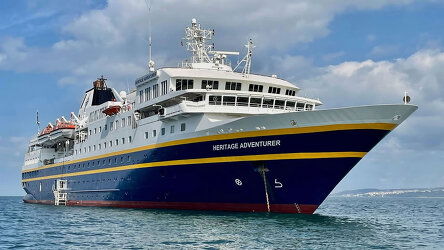
Built for polar exploration with a great track record, guests cruise in comfort onboard the Heritage Adventurer. Read more
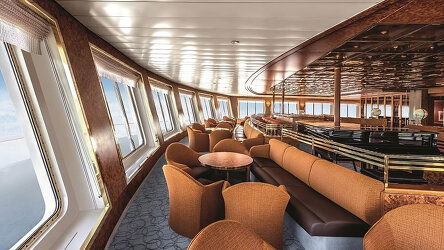
Sit back and enjoy a drink in the Observation Lounge, or experience 360-degree views from the Observation Deck. Read more

To make sure every guest has an elevated experience, Heritage Adventurer comes ready with a fleet of 14 zodiacs. Read more
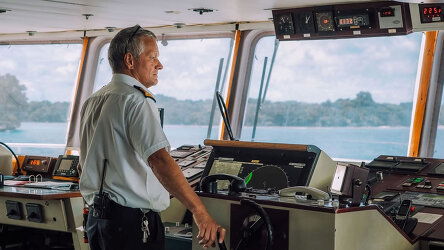
Take a look behind the scenes and see the captain at work, learn how the ship works and enjoy some of the best views onboard. Read more

Keep your fitness up during your cruise in the onboard gym or alleviate and revitalise yourself in the spa. Read more
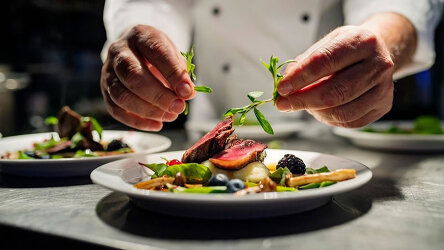
Whether it's a quick bite to eat or a multi-course evening meal, Heritage Adventurer's all-inclusive dining will satisfy your hunger. Read more
Brochure
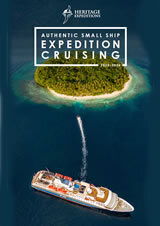
Heritage Expeditions Worldwide (2023-25)
Availability Click on prices below to view cabin upgrades and details
Tour & cruises prices are per person. Prices shown have savings applied, are subject to availability and may be withdrawn at any time without notice. Pricing and trip details are correct at this point in time, however are subject to confirmation at the time of booking and are subject to change by Heritage Expeditions. For cruise itineraries, cabin images are sourced from Heritage Expeditions. These should be treated as indicative only. Cabin inclusions, upholsteries and room layout may differ to the image(s) shown depending on the ship selected and your sailing dates.
Similar Cruises
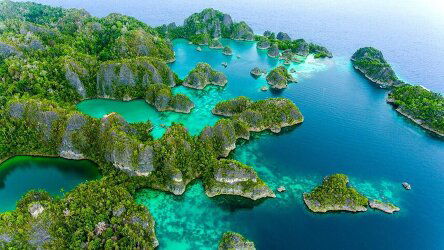
18 Days Bali Cairns
Operated By: Heritage Expeditions
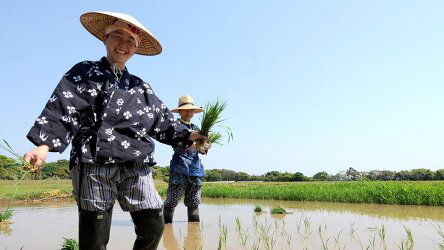
16 Days Osaka Osaka
Operated By: Heritage Expeditions
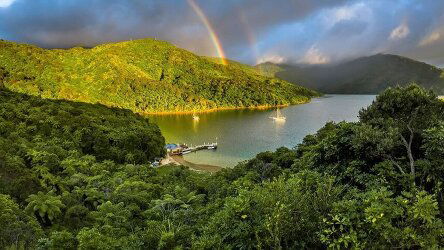
14 Days Queenstown Auckland
Operated By: Heritage Expeditions
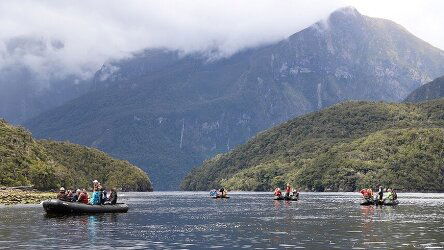
12 Days Queenstown Auckland
Operated By: Heritage Expeditions
